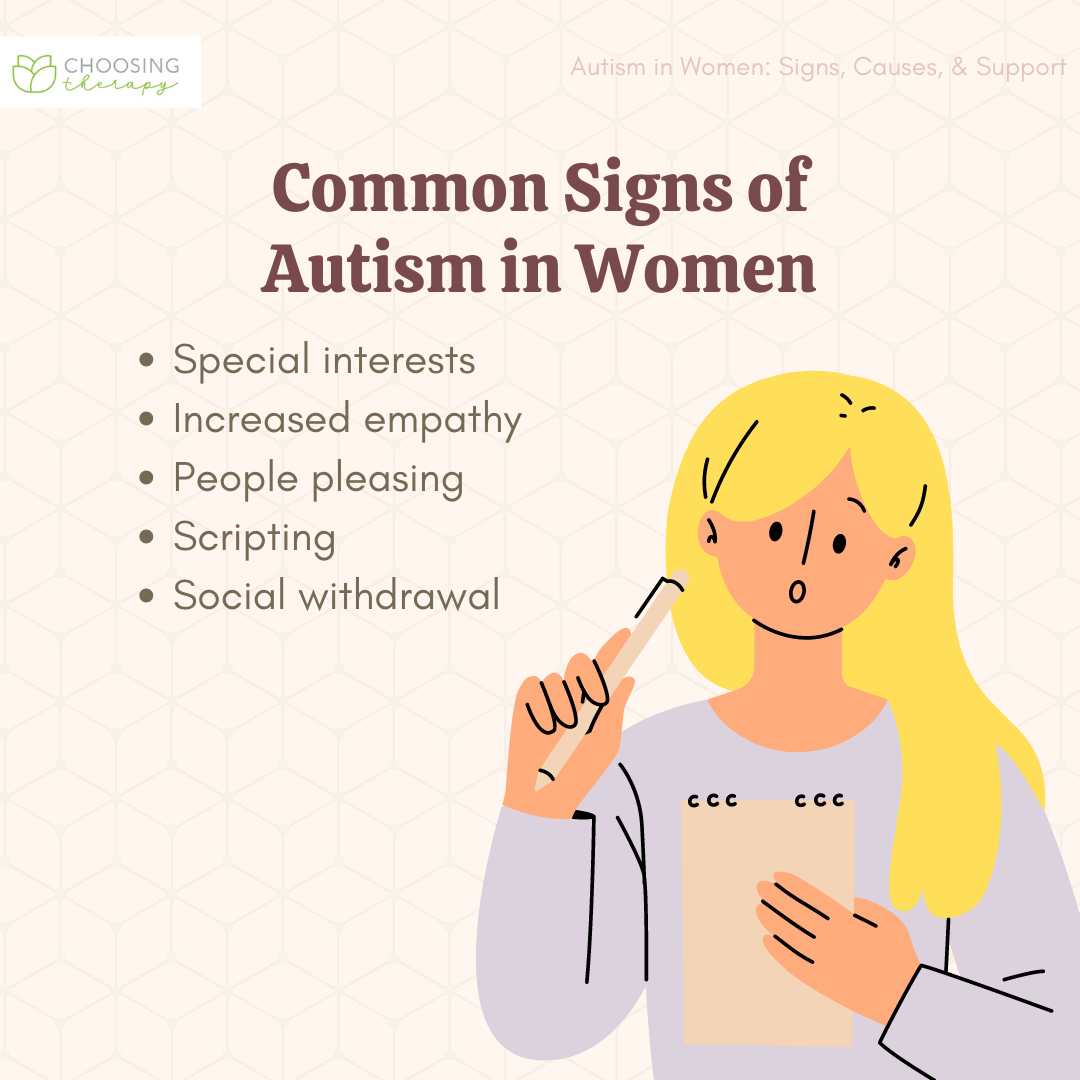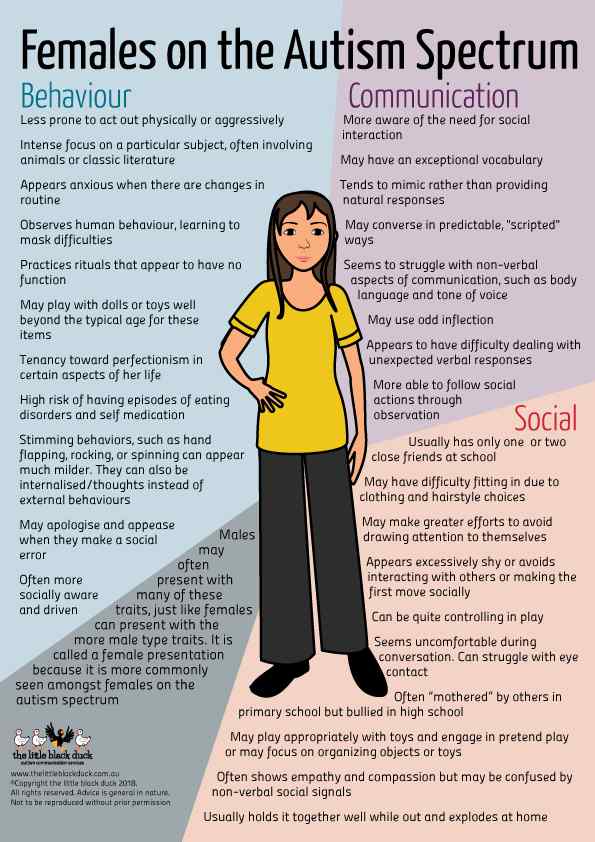Imagine navigating life with a map that doesn’t quite match the terrain. This is how many women experience Autism Spectrum Disorder (ASD).
While ASD symptoms in men are widely recognized, the signs in women can be more subtle, often leaving you or someone you know feeling misunderstood or overlooked. Are you curious about what these symptoms look like and why they can be so elusive?
You’re not alone. Many women, perhaps even yourself, are seeking answers and clarity. By understanding these unique symptoms, you empower yourself to better support those around you or even gain insights into your own experiences. Ready to uncover the signs that are often hidden in plain sight? Let’s dive into the fascinating world of ASD symptoms in women and unveil the mysteries that can make all the difference.

Credit: www.choosingtherapy.com
Unique Presentation In Women
Autism Spectrum Disorder (ASD) often presents differently in women compared to men. Many women go undiagnosed or misdiagnosed due to subtle symptoms. Recognizing these unique presentations is crucial for understanding and support. Women with autism might exhibit symptoms that are not typical or expected.
Subtle Social Challenges
Women with ASD might struggle with social interactions but hide it well. They often mimic behaviors to fit in with peers. This masking makes their challenges less visible to others. They may feel anxious in social situations but appear calm.
Masked Communication Difficulties
Communication struggles can be hidden by women with autism. They might rehearse conversations in advance. Understanding non-verbal cues can be challenging. Their speech might be direct, missing social nuances.
Emotional Sensitivity
Women with ASD may experience heightened emotional sensitivity. They often feel overwhelmed by emotions. This sensitivity can lead to anxiety or depression. Loud noises or bright lights may cause discomfort.

Credit: spot.com.hk
Common Misdiagnoses
Symptoms of Autism Spectrum Disorder in women often go unnoticed, leading to frequent misdiagnoses. Social anxiety or depression is commonly mistaken for autism. This results in delayed or inadequate support.
Autism Spectrum Disorder (ASD) in women often goes unnoticed. This leads to frequent misdiagnosis. Women with ASD may experience symptoms differently than men. Their symptoms are subtle and can overlap with other conditions. Understanding common misdiagnoses is crucial.
Anxiety Disorders
Women with ASD often show anxiety symptoms. These symptoms can be intense. Social situations can cause stress and fear. Many women are misdiagnosed with anxiety disorders. They may get treatment for anxiety instead of ASD. This can lead to ineffective care.
Depression And Mood Disorders
Depression is another common misdiagnosis in women with ASD. They might feel isolated or misunderstood. This can cause mood swings and sadness. These symptoms can mimic depression. Many women receive treatment for mood disorders. But this does not address their underlying ASD.
Attention Deficit Hyperactivity Disorder
ADHD symptoms overlap with ASD. Women may struggle with focus and organization. They might be restless or impulsive. These signs often lead to an ADHD diagnosis. But their challenges may stem from ASD. Understanding these overlaps is essential for proper diagnosis. Proper diagnosis leads to better support and care.
Impact On Daily Life
Autism Spectrum Disorder (ASD) affects individuals in diverse ways. For women, the symptoms can impact daily life significantly. Recognizing these impacts helps in understanding the challenges faced. Awareness leads to better support and accommodations.
Workplace Challenges
Women with ASD often face difficulties in the workplace. Sensory overload from bright lights can be overwhelming. Social cues in conversations may be hard to interpret. This can affect teamwork and communication. Understanding instructions might require additional clarity. These challenges can lead to increased anxiety and stress.
Relationships And Social Interactions
Social interactions can be daunting for women with ASD. Misreading social cues often creates misunderstandings. Forming friendships may be difficult. This can lead to feelings of isolation and loneliness. Maintaining relationships requires significant effort. Often, the need for solitude and quiet time is misunderstood.
Daily Routine Management
Managing daily routines can be challenging. Changes in plans can cause stress and confusion. Following schedules helps in maintaining order. Sensory sensitivities might affect diet and clothing choices. These sensitivities can make routine tasks overwhelming. Understanding these needs can aid in creating supportive environments.
Research And Awareness
Recognizing autism spectrum disorder symptoms in women can be challenging due to subtler signs. Social challenges, sensory sensitivities, and intense focus on interests are common. Understanding these symptoms aids early diagnosis and support.
Understanding Autism Spectrum Disorder (ASD) symptoms in women is gaining more attention as research and awareness continue to evolve. For many years, the unique experiences of women with ASD were overshadowed by a focus on male-centered studies. Now, as more light is shed on the female presentation of ASD, we’re beginning to appreciate the nuances and differences that exist. This shift is crucial for accurate diagnosis and support for women on the spectrum.
Historical Bias In Studies
Historically, autism research has predominantly focused on males. The ratio of diagnosed males to females has often been cited as 4:1. This skewed perspective led to a male-centric view of ASD symptoms, leaving many women undiagnosed or misdiagnosed. Consider the story of a woman who only received her ASD diagnosis in her 40s. Her symptoms were often dismissed as shyness or anxiety. This delay in diagnosis highlights the urgent need for more inclusive research.
Emerging Trends In Female-focused Research
Recent studies are beginning to prioritize female-specific symptoms. Researchers are now considering how social expectations and gender roles influence the expression of ASD in women. This shift is helping to identify patterns that differ from those observed in men. For example, women with ASD might excel at masking their symptoms. They often mimic social behaviors to fit in, which can lead to exhaustion and mental health challenges. Recognizing these trends is critical for developing supportive interventions.
Importance Of Gender-specific Diagnosis
Accurate diagnosis is essential for providing effective support and resources. Gender-specific diagnostic criteria are being developed to address the unique needs of women with ASD. This approach acknowledges that women may present differently and require tailored support. Imagine a world where all women receive timely and accurate diagnoses. How might their lives improve with the right support and understanding? By focusing on gender-specific criteria, we can ensure that women receive the help they need. Increased awareness and research into ASD symptoms in women are vital steps toward equality in diagnosis and treatment. By addressing historical biases and embracing new research trends, we can better support women on the autism spectrum. Your awareness and understanding can make a significant difference in their lives.
Support And Resources
Recognizing autism spectrum disorder symptoms in women is vital for early support. Resources like counseling and community groups offer guidance. Understanding these symptoms helps provide tailored support for women, enhancing their well-being and daily life.
Autism Spectrum Disorder (ASD) presents unique challenges and opportunities for support, especially for women whose symptoms often go unnoticed. Understanding and accessing the right support and resources can make a significant difference. Whether it’s therapeutic interventions, community support networks, or educational programs, these resources are crucial in fostering growth and empowerment.
Therapeutic Interventions
Therapeutic interventions can be transformative for women with ASD. These therapies aren’t one-size-fits-all and may range from cognitive behavioral therapy to sensory integration therapy. A personal friend found solace in art therapy, where she expressed herself without judgment. Have you considered how creative therapies might offer you a voice when words fail? Many women discover that personalized therapy plans can help them navigate daily challenges. You might find that a structured routine or mindfulness exercises provide clarity and calm.
Community Support Networks
Community support networks offer a sense of belonging and understanding. These groups can be physical meetups or online forums where experiences and strategies are shared. Joining a local support group can be an eye-opener. You meet people who understand your journey, and it’s comforting to know you’re not alone. What stories and advice might you share with such a group? Online communities are equally powerful. They offer 24/7 access to resources and support. Imagine having a virtual shoulder to lean on during tough times.
Educational Programs
Educational programs are pivotal in equipping women with ASD with necessary skills and knowledge. These programs might include workshops, seminars, or online courses tailored to specific needs. One woman I know attended a coding workshop and unearthed a hidden talent for programming. Are there skills or interests you’ve yet to explore that might be nurtured in an educational setting? Schools and universities increasingly offer specialized support programs. These programs aim to create inclusive environments where learning can thrive. Could tapping into these resources enhance your educational journey? By tapping into these resources, you empower yourself with tools and knowledge to navigate life with ASD. What’s the next step you’ll take to access these support systems?

Credit: literallyausome.com.au
Personal Stories And Experiences
Personal stories offer a unique view of Autism Spectrum Disorder (ASD) in women. Many women share their journeys, highlighting the varied symptoms and challenges they face. These experiences bring awareness to the often overlooked signs of autism in females. Stories can inspire others and foster a sense of community. Here, we delve into personal narratives, the role of family and friends, and how women overcome challenges.
Narratives From Women With Autism
Sarah, diagnosed at 30, felt misunderstood her whole life. She shares how her sensitivity to noise and social situations impacted her daily routine. Emma talks about feeling different but not knowing why until her diagnosis. Her story reveals the struggle of masking symptoms to fit in. These narratives highlight the importance of understanding autism in women.
Role Of Family And Friends
Support from family and friends plays a crucial role. Jane’s sister helped her recognize her symptoms and seek help. Her story shows the importance of having a supportive network. Friends can provide comfort and understanding. They can also help in navigating social situations. Family and friends are often vital in an autistic woman’s journey.
Overcoming Challenges
Women with autism face unique challenges. Yet, many find ways to thrive. Lisa learned to embrace her differences and found a supportive community online. Her story is one of resilience and strength. Many women use their experiences to help others. They become advocates and raise awareness. Overcoming challenges often leads to personal growth and a sense of empowerment.
Frequently Asked Questions
How Do I Tell If I’m An Autistic Female?
Observe social interaction challenges, intense focus, sensory sensitivities, and routine preference. Consult a professional for diagnosis.
What Does High Functioning Autism Look Like In A Woman?
High functioning autism in women may include strong attention to detail, difficulty with social interactions, and sensory sensitivities. Women may mask symptoms, leading to misdiagnosis. They often exhibit intense focus on interests and challenges in understanding social cues. Awareness and understanding help in recognizing these traits.
What Is The Checklist For Asd In Females?
The ASD checklist for females includes difficulty in social interactions, sensory sensitivities, repetitive behaviors, and challenges in understanding non-verbal cues. Females may mask symptoms, leading to late diagnoses. Emotional regulation issues and intense interests are common. Observing communication patterns and social responses aids in identification.
Early intervention is crucial.
What Is Level 1 Autism In Adults?
Level 1 autism in adults is characterized by mild social difficulties. Adults may need minimal support in managing social interactions and organizing daily tasks. They often have average to above-average intelligence and can lead independent lives with some guidance. Early diagnosis and tailored support are crucial for better outcomes.
Conclusion
Understanding autism symptoms in women is crucial for accurate diagnosis. Women often show different signs than men. Recognizing these unique symptoms helps provide better support. Early identification can lead to more effective interventions. It also promotes a more inclusive society.
Awareness creates empathy and understanding. This can improve the quality of life for those affected. Keep learning and sharing knowledge. Encourage open discussions about autism in women. Together, we can make a difference.
